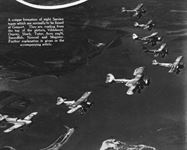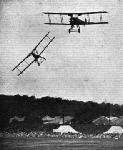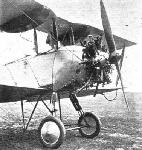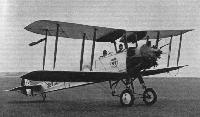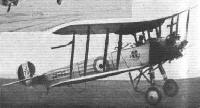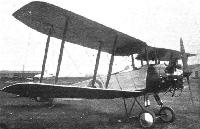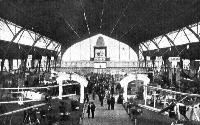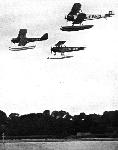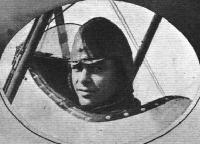
Варианты
Avro серии 504
<...>
Удачный опыт использования самолета в годы Первой мировой войны в качестве учебного заставил конструкторов задуматься о возможности оснащения машины одним из новых звездообразных моторов. В результате появилась серия 504N, отличавшаяся от предшественников новым шасси без центральной лыжи и элеронами новой формы. Два таких самолета в 1925 году заказало Министерство авиации, их собрали из двух недостроенных в 1918 году экземпляров. На одну установили 100-сильный звездообразный мотор Bristol Lucifer, на вторую - 180-сильный звездообразный мотор Armstrong Siddeley Lynx. Для серийных машин выбрали мотор Lynx, всего в 1925-1932 годах было построено 598 самолетов.
Самолеты серии 504N в авиационных училищах британских ВВС пришли на смену серии 504K и использовались в качестве связных во вспомогательных ВВС Британии и авиационных эскадрильях университетов.
Обучение пилотированию по приборам в Британии впервые началось в сентябре 1931 года в Уиттеринге, куда поступили шесть самолетов серии 504N,снабженных специальными колпаками и указателями крена.
Фюзеляжи первых серийных самолетов собирались из дерева, но затем перешли на ферменную конструкцию, сваренную из стальных труб. На первые машины ставили сужающиеся в плане элероны, на поздние - элероны прямоугольной в плане формы. Почти 80 ранее построенных самолетов серии 504K модернизировали до уровня серии 504N.
Самолеты серии 504N экспортировались в Бельгию, Бразилию, Чили, Данию, Грецию, Японию, Швецию, Таиланд и Южную Африку. Лицензионная сборка была налажена в Дании и Бельгии. В Канаде некоторое число самолетов серии 504K канадских ВВС силами фирмы "Canadian Vickers" прошли модернизацию в серию 504N, эта же компания также строила серию 504N "с нуля" в сухопутном и морском (с одним поплавком) вариантах.
Один самолет серии 504N продали в 1927 году Японии, где было налажено производство этих машин под обозначением Yokosuka K2Y, а в 1928 году появился K2Y1 с мотором Armstrong Siddeley Mongoose мощностью 130 л.с. производства фирмы "Mitsubishi". В 1929 году начал летать улучшенный K2Y2 с мотором Gasuden Jimpu 2 мощностью 160 л.с. До 1940 года различными фирмами было построено примерно 360 самолетов K2Y.
В 1932 году британские ВВС выбрали для замены учебных Avro серии 504N самолет Avro Tutor. Но некоторое количество самолетов серии 504N продолжали эксплуатироваться как гражданские. На военную службу серию 504 "призвали" в 1940 году, когда семь гражданских машин были реквизированы для военных нужд британскими ВВС. Два из них сгорели при пожаре в ангаре, а еще два пришлось утилизировать. Три уцелевших аэроплана поступили на вооружение звена специального назначения, где их использовали для буксировки деревянных планеров над морем в целях тренировки расчетов РЛС.
ТАКТИКО-ТЕХНИЧЕСКИЕ ХАРАКТЕРИСТИКИ
Avro серии 504N
Тип: двухместный самолет первоначального обучения
Силовая установка: один звездообразный мотор Armstrong Siddeley Lynx IVC мощностью 180 л. с. (134 кВт)
Характеристики: максимальная скорость на уровне моря 161 км/ч; крейсерская скорость на оптимальной высоте 137 км/ч; скороподъемность 235 м/мин; практический потолок 4450 м; дальность 402 км
Масса: пустого 718 кг; максимальная взлетная 1016 кг
Размеры: размах крыла 10,97 м; длина 8,69 м; высота 3,33 м; площадь крыльев 29,73 м1
- Описание
Фотографии
-
Aeroplane Monthly 1978-07 / A.Jackson - Avro 504N /RAF Piston Trainers/ (2)
Регистрационный номер: F8713 A lively study of F8713, a 504K conversion serving with Cambridge University Air Squadron.
-
Aeroplane Monthly 1983-12 / L.Coombs - Cockpits of the RAF (3)
Регистрационный номер: K1963 Avro 504N K1963 of the CFS on blind solo.
-
Aeroplane Monthly 1978-07 / A.Jackson - Avro 504N /RAF Piston Trainers/ (2)
Регистрационный номер: K1244 [4] A famous shot of 504N K1244 of the CFS, Wittering, with the blind flying hood pulled over the rear cockpit, June 1931.
-
Мировая Авиация 110
Регистрационный номер: K1244 [4] Самой известной частью британских ВВС, эксплуатировавшей Avro 504N, стала Центральная авиационная школа. Данный самолет использовался школой с 1931 года. На фотографии хорошо виден колпак, который в раскрытом положении закрывал кабину курсанта.
THE AVRO-LYNX: A development of the 504, this machine differed mainly in the engine unit and undercarriage. -
Flight 1931-07 / Flight
Регистрационный номер: K1244 [4] INSTRUMENT FLYING: These two pictures of the same Avro-Lynx illustrate instruction in flying solely by instruments. In the first the head of the pupil can be seen, in the second it is hidden by the hood. The instructor is in the front cockpit.
-
Мировая Авиация 110
Регистрационный номер: K1049 [2] Известный как Lynx-Avro, 504N сменил 504K в пяти авиационных школах британских ВВС. Самолеты также использовались во Вспомогательных ВВС в качестве связных самолетов и как учебные в авиационных эскадрильях университетов.
-
Flight 1929-08 / Flight
Lynx-Avros flown by the Oxford University Squadron group diving in formation over Manston
-
Flight 1931-07 / Flight
Oxford University Air Squadron is at present undergoing its annual training at Eastchurch. This photograph shows a formation of "Avros" (Lynx) over the estuary of the Thames.
-
Flight 1932-05 / Flight
A FORMATION OF AIRCRAFT TYPES USED FOR INSTRUCTION AT THE CENTRAL FLYING SCHOOL: From left to right, Gamecock, Atlas, Moth, III.F, Avro-Lynx, Siskin and Bulldog.
Другие самолёты на фотографии: Armstrong Whitworth Atlas / Ajax - Великобритания - 1925Armstrong Whitworth Siskin - Великобритания - 1921Bristol Bulldog - Великобритания - 1927De Havilland Gipsy Moth / Moth X - Великобритания - 1928Fairey Fairey IIIF - Великобритания - 1926Gloster Gamecock - Великобритания - 1925
-
Flight 1931-07 / Flight
A MIXED GRILL: A formation of seven different types over Wittering, viz., "Gamecock," "Atlas," "Moth," "Fairey III F," "Avro-Lynx," "Siskin," and "Bulldog."
Другие самолёты на фотографии: Armstrong Whitworth Atlas / Ajax - Великобритания - 1925Armstrong Whitworth Siskin - Великобритания - 1921Bristol Bulldog - Великобритания - 1927De Havilland Gipsy Moth / Moth X - Великобритания - 1928Fairey Fairey IIIF - Великобритания - 1926Gloster Gamecock - Великобритания - 1925
-
Flight 1938-05 / Flight
A unique formation of eight Service types which are normally to be found at Gosport. They are, reading from the top of the picture, Vildebeest, Osprey, Shark, Tutor, Avro 504N, Swordfish, Nimrod and Magister.
Другие самолёты на фотографии: Avro Tutor/Sea Tutor/Prefect / Type 621/646/626 - Великобритания - 1929Blackburn Shark / B-6 - Великобритания - 1933Fairey Swordfish - Великобритания - 1934Hawker Nimrod - Великобритания - 1931Hawker Osprey - Великобритания - 1930Miles Magister / M.14 - Великобритания - 1937Vickers Vildebeest / Type 132 - Великобритания - 1928
-
Aeroplane Monthly 1994-12 / G.Wansbrough-White - What's in a name? (2)
A formation of eight types based at Gosport in 1938. They are, from the top, Vildebeest, Osprey, Shark, Tutor, Avro 504N, Swordfish, Nimrod and Magister. The 504N was flying at full bore while the Kestrels of the Nimrod and Osprey were throttled well back. Pilots of this “Heinz” formation were drawn from the RAF, Army, Navy and Marines; the aircraft came from the Coastal Defence Development Flight and the Torpedo Training Unit.
Другие самолёты на фотографии: Avro Tutor/Sea Tutor/Prefect / Type 621/646/626 - Великобритания - 1929Blackburn Shark / B-6 - Великобритания - 1933Fairey Swordfish - Великобритания - 1934Hawker Nimrod - Великобритания - 1931Hawker Osprey - Великобритания - 1930Miles Magister / M.14 - Великобритания - 1937Vickers Vildebeest / Type 132 - Великобритания - 1928
-
Flight 1936-05 / Flight
Nine Avro 504 Ns put up an unusually good exhibition of formation flying at Hendon on Saturday.
-
Aeroplane Monthly 1982-05 / M.Turner - Avro 504N
Регистрационный номер: J8519, K1815 A CAMBRIDGE FORMATION OVER SALISBURY PLAIN: Light blue bands are painted round the fuselage, the chief instructor's machine having two bends.
A trio of CUAS 504Ns with the chief instructor’s aircraft, J8519, in the middle. -
Aeroplane Monthly 1982-05 / M.Turner - Avro 504N
Регистрационный номер: H9816, J8546, J8746 Another group from the Cambridge University Air Squadron, this trio comprises H9816 (a conversion), J8546 and J8746.
-
Flight 1931-07 / Flight
The Oldest and the Youngest.
-
Flight 1929-07 / Flight
Old Sarum: An aerial view of one of the Cambridge Air Squadron's Avro-Lynx machines flying low and parallel to the old Roman ruins of Old Sarum in Wiltshire, close to the aerodrome where the Squadron is now in training.
-
Aeroplane Monthly 1982-05 / M.Turner - Avro 504N
A lone CUAS 504N flying from Old Sarum in the summer of 1931.
-
Flight 1935-11 / Flight
WINGED WORDS. The 150 ft. Remembrance appeal which was towed over London by a Lynx-Avro piloted by Mr. F. Gordon Freeman. The letters, which are of fabric, with stiffeners in the leading edges, are mounted on tapes. The sign is laid out on the ground, and the pilot then flies over it, picks it up with a hook, and "peels" it off. Aerial Sites Ltd., of Hanworth and London, were the operators.
-
Flight 1931-07 / Flight
A Cambridge "Rag."
-
Flight 1932-07 / Flight
The instructor just avoids collision with his clumsy pupil in the demonstration of instructional flying on Avro-Lynx.
-
Aeroplane Monthly 1998-09 / J.Golley - Working with a genius (1)
Пара Avro серии 504N выполняют крены в полете на предельно малой высоте. Превосходные летные качества позволяли самолету оставаться на вооружении британских ВВС до начала 1930-х годов.
Flt Lt Damant and Fg Off Beaumont performing their unforgettable crazy flying sequence on two very forgiving Avro 504Ns at the 1931 RAF Pageant, perhaps one of the most popular events in the ’thirties.
In competition with representatives of other RAF Flying Training Schools, Whittle and fellow instructor Fg Off George “Titch" Campbell won the honour for No 2 FTS of performing the Crazy Flying event at the June 1930 RAF Display at Hendon. Seen here are Flt Lt S. K. Damant and Fg Off J. Beaumont of 5 FTS, doing the same at the 1931 RAF Display in the same aircraft type, the Avro 504N. -
Aeroplane Monthly 1978-04 / ??? - Ragtime 504s
Another view of Fg Off G. E. Campbell and Fl Sgt Brown defying all the laws of nature at Hendon in July 1929.
-
Aeroplane Monthly 1978-04 / ??? - Ragtime 504s
EVENT 11, "CRAZY FLYING": Two Avro-Lynx of No. 2 Flying Training School, piloted by F./O. G. E. Campbell and Flt./Sergt. Brown mix themselves up so much, that we regret we cannot say which is which
Fg Off G. E. Campbell and Flt Sgt Brown cavorting around Hendon Aerodrome at the RAF Pageant in July 1929. -
Aeroplane Monthly 1978-04 / ??? - Ragtime 504s
Crazy Flying: F/O Campbell and P/O Whittle, of No. 2 Training School, give an exhibition on Avro-Lynx Machines.
Fg Off G. E. Campbell and Flt Sgt Brown cavorting around Hendon Aerodrome at the RAF Pageant in July 1929. -
Flight 1928-07 / Flight
STUNTING AT HENDON: Avro-Lynx machines flown by Flying Officers Bremridge and Campbell of No. 2 Flying Training School.
-
Flight 1927-07 / Flight
THE MORNING'S PROGRAMME: 1, Aerobatics on an "Avro-Lynx."
-
Flight 1927-07 / Flight
THE BIRMINGHAM AIR PAGEANT: Three Avro-Lynx "bombers" from No. 605 County of Warwick Squadron attempt to blow up an Eastern Castle Bromwich.
-
Flight 1929-05 / Flight
CRAZY FLYING AT NORTHOLT: Three studies of "Air-Madness" on the part of Flying-Officer Campbell and Flight-Sergt. Brown on Avro-Lynx machines
-
Flight 1927-10 / Flight
Sherburn Air Pageant: Two R.A.F. officers, Flight-Lieuts. Lydford and Fogarty, put up a thrilling exhibition of crazy flying both on the ground and above. Here Flight-Lieut. Fogarty is seen landing on one wheel in the Avro-Lynx.
-
Aeroplane Monthly 1978-04 / ??? - Ragtime 504s
"LET'S ALL GO MAD": Crazy Flying at the Birmingham Air Pageant was crazier than ever. We are not quite certain but we think he is flying backwards in the picture.
-
Aeroplane Monthly 1978-04 / ??? - Ragtime 504s
Регистрационный номер: H2972 "LET'S ALL GO MAD": Crazy Flying at the Birmingham Air Pageant was crazier than ever. On the picture Flight-Lieut. F. J. Fogarty is executing a pirouette with one wheel of his Avro-Lynx actually touching the ground.
Flt Lt F. J. Fogarty performing in Avro 504N H2972 at the Birmingham Air Pageant, just a few days after appearing at the RAF Pageant at Hendon, July 1927. -
Aeroplane Monthly 1977-09 / Personal album
Регистрационный номер: JR8725, J8725 An Avro 504N participates in a forced landing competition at Abu Suier (hence the flag markers). The aircraft’s identity is J8725, the ‘R’ being inserted to denote that it has undergone a rebuild. This practice lapsed in the mid-thirties. An Armstrong Siddeley Lynx radial powered this long-serving ab initio trainer.
-
Aeroplane Monthly 1977-09 / Personal album
Регистрационный номер: JR8983 Another rebuilt Lynx-engined Avro 504N, JR8983 sports a blind-flying hood, seen folded down behind the pupil’s cockpit. The characteristic oleo-pneumatic undercarriage and twin underwing fuel tanks are well portrayed.
-
Flight 1931-07 / Flight
Регистрационный номер: K1244 [4] TAKING OFF SOLO BY INSTRUMENTS ONLY: An instructor (Mr. W.E.P.Johnson) takes off solo with the hood up. He put the machine into a spin and flattened out before lowering his hood. We believe that this is the first photograph ever published of this extraordinary feat.
-
Aeroplane Monthly 1981-04 / P.Heath - Tales of a target-tower
Регистрационный номер: J9271 Another 504N, J9271, landing on HMS Courageous during a training landing.
-
Aeroplane Monthly 1981-04 / P.Heath - Tales of a target-tower
Регистрационный номер: K1974 Avro 504N, K1974, lands on HMS Glorious in 1930.
-
Aeroplane Monthly 1978-07 / A.Jackson - Avro 504N /RAF Piston Trainers/ (2)
Регистрационный номер: K1813 K1813 during deck landing trials in 1931.
-
Flight 1927-06 / Flight
"Avro-Lynx" (Armstrong-Siddeley "Lynx"). This is one of the offshoots of that ancient and valiant old warrior, the 504K, which was designed as long ago as 1912, and which has since then passed through several modifications - this particular machine being one. Fitted with the Armstrong-Siddeley "Lynx," this version of the 504 has given very satisfactory results. It is safe to say that more pilots have passed through their preliminary training on Avros of various models than any other type. In fact, the Avro is sort of "handy man" always to be relied upon for any purpose.
-
Flight 1933-11 / Flight
AB INITIO: The Special Reserve officers of No. 502 (Ulster) (Bomber) Squadron are taught to fly ab initio in the squadron in Avro "Lynx" two-seaters.
-
Aviation Historian 11 / M.Willis - From Farmer to Test Pilot /Duncan Menzies/ (1)
Flying Officer Menzies (third from right, standing) poses with a group beside an Avro 504N, a type on which he established a reputation as a “crazy flying” specialist. The 504N was an updated 504K, with the latter’s rotary engine replaced with an Armstrong Siddeley Lynx radial engine, hence being known as the “Lynx-Avro”.
-
Aeroplane Monthly 1978-07 / A.Jackson - Avro 504N /RAF Piston Trainers/ (2)
A standard “Lynx-Avro”, showing the two 18gal underwing fuel tanks and the undercarriage suspension.
-
Flight 1924-05 / Flight
THE AVRO "504 N": View showing Siddeley "Lynx" engine, oleo undercarriage, and gravity petrol tanks. This machine will be exhibited at Prague.
-
Aeroplane Monthly 1979-03 / J.Corlett - One good turn
GENTLE PERSUASION: Staging the "Lynx" engine on one of the C.U.A.S. Avro 504's by means of a Hucks starter.
A 504N of the Cambridge University Air Squadron, has the Hucks shaft mated to the dog in its spinner.
A CUAS 504N’s Lynx coaxed into life by a Hucks starter at Netheravon in July 1934. -
Flight 1930-06 / Flight
Регистрационный номер: J8738 [3] THE AVRO-LYNX: One of the variations on the famous old "504," this machine has been the standard training machine of the R.A.F. for many years. The engine is a "Lynx."
-
Aeroplane Monthly 1982-05 / M.Turner - Avro 504N
Регистрационный номер: J8738 [3] CUAS 504N J8738 taking off from Old Sarum during the 1928 summer camp.
-
Flight 1924-05 / Flight
The "Avro-Lynx" will be exhibited at Prague.
-
Aeroplane Monthly 1978-07 / A.Jackson - Avro 504N /RAF Piston Trainers/ (2)
Регистрационный номер: J733 Lucifer-powered J733, the first of two 504N evaluation prototypes supplied to the Air Ministry in 1924.
-
Aeroplane Monthly 1978-07 / A.Jackson - Avro 504N /RAF Piston Trainers/ (2)
Регистрационный номер: G-EAJB Avro's development aircraft, G-EAJB, with skid and oleo undercarriage and tapered ailerons, at Filton in 1921 as a Lucifer testbed.
-
Aeroplane Monthly 1982-10 / P.Capon - Capon's Corner
Регистрационный номер: G-EBKQ [9] Avro Type 582 G-EBKQ with single interplane struts and 180h.p. Lynx IVC engine, at Hamble in March 1927.
-
Flight 1927-03 / Flight
Регистрационный номер: G-EBKQ [9] A REAL 504 "K": The Avro-Lynx "Tourer" was seen in public for the first time at the Norwich demonstration. It is characterised by wings of bi-convex section, "K" interplane struts, and Frise type ailerons on the bottom plane only. This machine handles extraordinarily well, and the wing section used gives a stationary centre of pressure.
-
Flight 1927-07 / Flight
Регистрационный номер: G-EBKQ [9] FLYING BETWEEN SERMONS: By using an Avro aeroplane the Bishop of Willochra, S. Australia, who attended the Anglo-Catholic Conference in London, was able to preach in London on Sunday morning last, and in Manchester in the afternoon, Our photograph shows the Bishop at Woodford after landing. His pilot was Mr. Goodfellow, of the Lancashire Aero Club. The machine left London at 1 p.m. and landed at Manchester at 2.30 p.m.
-
Aeroplane Monthly 1982-10 / P.Capon - Capon's Corner
Регистрационный номер: G-EBKQ [9] The same aircraft with normal struttery and engined with a 150 h.p. Mongoose IIIA engine. As such G-EBKQ was known as an Avro 504O.
-
Flight 1925-07 / Flight
Регистрационный номер: G-EBKQ [9] THE KING'S CUP: Some of the first day's starters. 3, Bert Hinkler gets away on the Avro 504N.
-
Flight 1925-08 / Flight
Регистрационный номер: G-EBKQ [9] SOME OF THE LARGER MACHINES AT LYMPNE: From left to right, the Avro-Lynx, Bristol "Lucifer," Bristol "Bloodhound," S.E.5, Sopwith "Gnu," A.D.C.I, and a sky-writing S.E.5.
Другие самолёты на фотографии: Bristol Bloodhound / Type 84 - Великобритания - 1923Bristol Taxiplane / Primary Trainer - Великобритания - 1923Martinsyde A.D.C.1 / Nimbus - Великобритания - 1924RAF S.E.5 - Великобритания - 1916Sopwith Gnu - Великобритания - 1919
-
Aeroplane Monthly 1984-08 / R.Brooks - Penshurst /Gone but not forgotten/ (15)
Регистрационный номер: G-ACLV [2] Avro 504N G-ACLV of the Penshurst-based company Air Travel Ltd landing at Penshurst, probably in 1934.
-
Air-Britain Archive 1981-02
Регистрационный номер: G-ACLV [2] Avro 504N G-ACLV of Cobham's Circus photographed from Wessex G-EBXK during a display over Longford Park, Stretford, Manchester, at some time in the mid-30s
Другие самолёты на фотографии: Westland Wessex / Westland IV - Великобритания - 1929
-
Flight 1927-04 / Flight
NECK AND NECK: Hamersley on the Avro "Lynx" and Watt on his S.E.5A approaching the finishing line in the High-Power Handicap. Watt won by a few feet.
Другие самолёты на фотографии: RAF S.E.5 - Великобритания - 1916
-
Flight 1927-03 / Flight
"THE FIRST AIR LORD": Mr. John Lord flew over with Bert Hinkler in the new Avro "Tourer" with Armstrong-Siddeley "Lynx" engine. Inset the machine coming in to land.
-
Flight 1934-04 / Flight
One of the tightly packed queues of people waiting for joyrides in an Avro ("Lynx").
-
Aeroplane Monthly 1978-07 / A.Jackson - Avro 504N /RAF Piston Trainers/ (2)
Регистрационный номер: J9175, G-EBUY The Mongoose-powered Avro 504R variant J9175/G-EBUY at Martlesham in 1929.
-
Aeroplane Monthly 1986-02 / H.Morris - The Barnstormer's Apprentice (4)
Регистрационный номер: G-ABVH [3], J8372 [3] On the move. Cobham's National Aviation Day display team in close formation, led by the Handley Page W.10 G-EBMR, probably in 1933. Nearest the camera is Avro 504N G-ABVH, powered by a Mongoose IIIA. The author knew this aeroplane inside out during the time it was based at Penshurst with F. J. V. Holmes and later Air Travel Ltd.
Другие самолёты на фотографии: Handley Page H.P.18 (W.8) / H.P.30 (W.10) - Великобритания - 1919
-
Aeroplane Monthly 1976-12 / B.Williams - On tour with Cobham's Circus
Регистрационный номер: G-ABVH [3], J8372 [3] Martin Hearn atop Avro 504N G-ABVH.
-
Aeroplane Monthly 1976-12 / B.Williams - On tour with Cobham's Circus
Martin Hearn takes it easy on the top wing of an Avro 504N.
-
Aeroplane Monthly 1986-02 / H.Morris - The Barnstormer's Apprentice (4)
Регистрационный номер: G-ABVH [3], J8372 [3] Another view of Avro 504N G-ABVH. This aircraft was built for the RAF as J8372 and in 1932 was converted for civil use. Its registration was cancelled in December 1946.
-
Aeroplane Monthly 1980-04 / Personal album
Регистрационный номер: G-ACOK [3] Mrs Stapleton can be seen here, climbing out of the Avro 504N G-ACOK at Shoreham on August 19, 1934, after a 5/- flip around the local area.
-
Aeroplane Monthly 1986-05 / F.Bullmore - Circus Pilot (1)
Регистрационный номер: G-ACOK [3] This yellow and silver Mongoose-powered Avro 504N was owned by National Aviation Day Displays from April 1934 until March 1936, when it was sold to L. J. Rimmer at Hooton.
-
Air Pictorial 1958-01
Регистрационный номер: G-ACOM, E430 Old Avro. This delightful shot of one of Plane Advertising's Lynx-engined Avro 504Ns, G-ACOM (ex E430), was taken at Ford in 1937, and shows the underwing banner rollers.
-
Aeroplane Monthly 1982-10 / P.Capon - Capon's Corner
Регистрационный номер: G-EBVY [2] Avro 504N G-EBVY at Hamble in March 1928. Southampton Water can be seen in the background.
-
Aeroplane Monthly 1997-03 / D.Webb - Silent warriors /Tested & failed/
Регистрационный номер: G-ADBM [2], AX871 [2], K1055 [2] One of the Avro 504Ns flown by the Special Duties Flight at Christchurch during the summer of 1940. This pre-war photograph shows G-ADBM at the time it was banner-flying with Air Publicity.
-
Aeroplane Monthly 1977-04 / P.Wills - Radar guinea-pigs
Регистрационный номер: G-ADBM [2], AX871 [2], K1055 [2] Avro 504N G-ADBM was originally K1055, and flew with the CFS until sold off on April 23, 1934. Its first civilian owner was Air Travel Ltd, and after various other owners ’DBM's last prewar home was Heston, with Air Publicity Ltd, where it did much banner towing. In June 1940 ’DBM was impressed into RAF service and was allotted the serial AX871, although it is doubtful if it ever bore service markings. Because of its towing gear the 504N joined the Special Duties Flight at Christchurch, when it was flown by the author, but its career was cut short when it hit a watch hut whilst taking off from RAF Hawkinge on August 1, 1940.
-
Aeroplane Monthly 1991-10 / Personal album. Civil
Регистрационный номер: G-ADBS, K1251 L. G. Anderson’s Mongoose-powered Avro 504N G-ADBS was originally RAF machine K1251 and was attached to the RAF College. It was registered to Anderson in April 1935 but was lost in a crash at Bodmin, Cornwall, on August 16 that year.
-
Aeroplane Monthly 1991-05 / J.Havers - Field of endeavour (1)
Регистрационный номер: G-AEAA Avro 504N G-AEAA photographed at Kingswood Knoll in 1936. Brian Field’s dog Leo may be seen in the foreground. The 504N’s registration was cancelled in September 1938.
-
Aeroplane Monthly 1991-10 / Personal album. Civil
Регистрационный номер: G-AECS, J8548 Avro 504N G-AECS began life in RAF colours as J8548, originally attached to the CFS, in 1929. It had a habit of hitting stationary aircraft, first Avro 504K F8813 and then Avro 504N K1050. In 1936 it was sold to L. G. Anderson and later passed to the Christchurch-based Bournemouth Flying School. It was dismantled at Christchurch in 1940.
-
Aeroplane Monthly 1982-12 / Hanworth /Gone but not forgotten/ (14)
Регистрационный номер: G-AEMP Avro 504N G-AEMP almost camouflaged against Aircraft Exchange & Mart's Hanworth hangar.
-
Flight 1925-07 / Flight
AVROS FOR GREECE: Our photograph shows four of a batch of "Avro-Lynx" biplanes built for Greece. With its Oleo undercarriage and reliable Siddeley "Lynx" engine, the Avro 504N, is a remarkably successful training machine. Standing in front of the second machine from the right are representatives of the Greek Government.
-
Flight 1932-11 / Flight
Avro "Lynxes" of The University Air Squadron. The University Crest can be clearly seen.
-
Flight 1930-08 / Flight
The three types of machines with which this Squadron is equipped, namely, on the left: the D.H.9, of which there are four; centre the Westland "Wapiti," which number eight, and finally - sundry Avro "Lynx" biplanes.
Другие самолёты на фотографии: De Havilland D.H.9A - Великобритания - 1918Westland Wapiti - Великобритания - 1927
-
Aeroplane Monthly 1978-07 / A.Jackson - Avro 504N /RAF Piston Trainers/ (2)
Регистрационный номер: J8703, J9420 Three 504Ns of 601 Squadron, Auxiliary Air Force, in dark colour schemes. J8703 and J9420 are nearest.
-
Flight 1928-08 / Flight
AUXILIARY AIR FORCE MACHINES AT LYMPNE: In the foreground two Avro-Lynx, and behind a number of D.H.9a's.
Другие самолёты на фотографии: De Havilland D.H.9A - Великобритания - 1918
-
Flight 1928-06 / Flight
CAMBRIDGE UNIVERSITY AIR SQUADRON AT OLD SARUM: The afternoon parade. Three Bristol Fighters and six Avro Lynx.
Другие самолёты на фотографии: Bristol F.2A/F.2B Fighter - Великобритания - 1916
-
Flight 1931-08 / Flight
THE DARK BLUE AEROPLANES: Four "Bristol Fighters" and eight "Lynx-Avros" at Eastchurch. A dark blue line is painted on each fuselage.
Другие самолёты на фотографии: Bristol F.2A/F.2B Fighter - Великобритания - 1916
-
Aeroplane Monthly 1978-07 / A.Jackson - Avro 504N /RAF Piston Trainers/ (2)
Регистрационный номер: J9259 [2], K2367 [2] A line-up of Cambridge University Air Squadron 504Ns.
-
Aeroplane Monthly 1982-05 / M.Turner - Avro 504N
Регистрационный номер: J9259 [2], K2367 [2] THE GOOD OLD AVROS: The training machines of C.U.A.S.
CUAS aircraft at Netheravon in July 1932. K2367 formerly flew with the Oxford University Air Squadron. -
Aeroplane Monthly 1978-07 / A.Jackson - Avro 504N /RAF Piston Trainers/ (2)
Регистрационный номер: H2995, J9256, J9703 504K conversion H2995, two production 504Ns, J9703 and J9256, and the Hawker Horsleys of the aptly numbered 504 Squadron at Hucknall in 1932.
Другие самолёты на фотографии: Hawker Horsley / Dantorp - Великобритания - 1925
-
Flight 1934-09 / Flight
THE SQUADRON'S AIRCRAFT: In the front are the nine Westland "Wallaces" (Bristol "Pegasus"), while behind are two "Avro-Lynx" training machines with a "Wapiti" ("Jupiter") in between them.
Другие самолёты на фотографии: Westland Wallace / PV.3 / PV.6 - Великобритания - 1931Westland Wapiti - Великобритания - 1927
-
Flight 1938-04 / Flight
MAKING WAY FOR THE YOUNG ’UNS: A symbolic picture of a new Miles Magister on a visit to one of the few R.A.F. stations with an Avro 504N still on charge. The 504 series (and later the Tutor) were, of course, in the very front rank of training aircraft. Even to-day the Tutor is finding wide employment, but will eventually be superseded by monoplane types.
Другие самолёты на фотографии: Miles Magister / M.14 - Великобритания - 1937
-
Aeroplane Monthly 1991-03 / O.Thetford, A.Lumsden - On silver wings (6)
A line-up of 19 Sqn Siskin IIIAs - an Avro 504N may be seen in the background.
Другие самолёты на фотографии: Armstrong Whitworth Siskin - Великобритания - 1921
-
Flight 1924-06 / Flight
GENERAL VIEW FROM THE THIRD INTERNATIONAL AERO EXHIBITION AT PRAGUE: The photograph shows the British stand, with the "Avro-Lynx" on the left and the Blackburn "Dart" on the right.
Другие самолёты на фотографии: Blackburn Swift T.1 / Dart T.2 - Великобритания - 1920
-
Air Enthusiast 1996-05 / R.Bonser - Hamble Pictorial. Air Service Training in the 1930s
Регистрационный номер: G-EBKQ [9] AST grouping within the huge Avro/AW works building on the southern airfield. Foreground, left to right: Avro 616 Avian IVM floatplane G-ABKB, entered service in March 1931 and served on until being impressed, as instructional airframe 2073M, in February 1940. Saro A.17 Cutty Sark G-ACDP served AST from April 1933 until April 1939 when it was scrapped. Avro 504N G-EBKQ was converted by Avro at Hamble and flew for them in several capacities, the most famous of which was as Bert Hinkler’s mount in the gruelling 1925 King’s Cup which was staged out of Croydon over 1,608 miles and two days in July. In 1930 it was converted to 5040 seaplane status and joined AST, retiring in June 1931 to act as an instructional airframe.
Другие самолёты на фотографии: Avro Avian / Type 594/616 - Великобритания - 1926Saunders-Roe Cutty Sark / A.17 - Великобритания - 1929
-
Flight 1925-08 / Flight
AN AVRO FOR GREECE: We show above an Avro-Lynx seaplane about to start on a test flight before being delivered to the Greek Government.
-
Air Enthusiast 2001-07 / A.Thomas - In the Footsteps of Daedalus
Eight of the Greek NAS Velos T3A floatplanes (T-12, -13 and -23 can be identified) and one Avro 504O on a lake at Valtoudi during an exercise in the late 1920s.
Другие самолёты на фотографии: Blackburn Velos / T.3 - Великобритания - 1925
-
Flight 1932-11 / Flight
Регистрационный номер: G-EBKQ [9] FOR SEAMANSHIP: The good old Avro 504 is sufficiently difficult to handle on the water to teach pupils all there is to know about that side of the training; it is not used for flying training.
-
Flight 1932-11 / Flight
Регистрационный номер: G-EBKQ [9] WITH "BOOTS" ON: The A.S.T. seaplane fleet flying over our photographer at Hamble. Left to right, the " Avian," "Tutor," "504."
Другие самолёты на фотографии: Avro Avian / Type 594/616 - Великобритания - 1926Avro Tutor/Sea Tutor/Prefect / Type 621/646/626 - Великобритания - 1929
-
Мировая Авиация 38
Регистрационный номер: G-EBJD [2] Построенный для арктической экспедиции Оксфордского университета, самолет серии 504Q был спроектирован на базе моделей серии 504N и серии 504P. Самолет отличал фюзеляж большего объема с закрытой кабиной.
-
Flight 1924-09 / Flight
Регистрационный номер: G-EBJD [2] AN ARCTIC AVRO: These photographs show the Avro-"Lynx" of the Oxford University Arctic Expedition, which, under Mr. George Binney, has been making good use of the seaplane. The machine and its Armstrong-Siddeley "Lynx" carries a very heavy load, but nevertheless on test got off the water easily. The general views, 1 and 5, give a good idea of the lines of the machine. In 2 it is seen taxying, while 3 shows the special engine mounting designed for the "Lynx." A cowl is, of course, fitted for actual flying in the Arctic. 4 shows the Norwegian sled carried under the deck fairing. The front view, 6, shows the long floats, and the two extra petrol service tanks under the top plane. A third tank is built into the top centre-section.
-
Flight 1937-07 / Flight
Capt. Percival Phillips and Mrs. Phillips in front of the victorious Lynx Avro
-
Aeroplane Monthly 1983-06 / A.Jackson - Bats and Bantams (4)
Регистрационный номер: D9068 The Wasp I (Sheffield Simplex No. 10) with magnetos in front and other modifications, installed in the “fireproof” Avro 504K D9068.
-
Flight 1925-07 / Flight
THE KING'S CUP CONSOLATION HANDICAP: 3, Bert Hinkler, who obtained third place on A. V. Roe's Avro 504N.
-
Aeroplane Monthly 1988-02 / Personal album. Military
Регистрационный номер: K1807 Avro 504N K1807 of 607 Squadron was part of a batch delivered to the RAF between September and October 1930. The incident depicted here occurred at RAF Usworth and the 504N was struck off RAF charge in March 1934.
-
Aeroplane Monthly 1979-10 / Personal album
Регистрационный номер: J8980 This collision between a pair of Avro 504Ns piloted by Plt Offs Ryland and McInernys took place at Abu Sueir in 1930, but who was in which machine is not known. The distinctive oleo-pneumatic undercarriage and twin underwing tanks of this variant are conspicuous.
-
Aeroplane Monthly 1990-02 / Personal album. Military
Регистрационный номер: J8984, J8985 two 4 FTS Avro 504Ns making intimate contact at Landing Ground E near Aboukir on September 4, 1930. Avro 504N J8985 collided with J8984 during take-off, just after the latter had landed.
-
Aeroplane Monthly 1986-08 / F.Bullmore - Circus Pilot (4)
Регистрационный номер: G-ACOK [3] G-ACOK after a mishap in the mid-Thirties.
-
Air-Britain Archive 1981-03
Регистрационный номер: G-ACZC Clearly wearing the titles of The Aerial Advertising Company, this Avro 504N G-ACZC was caught taking a rather close look at Kew Gardens on 5.1.38 but apparently survived the encounter and was later impressed.
-
Aeroplane Monthly 1974-03 / J.Corlett - Write-off and laugh-off
Регистрационный номер: J8748 "ducking under the telegraph wires only to finish up in the hedge" - Avro 504N J8748, from which the pilot "had to perform vigorous labours to extricate himself."
-
Aeroplane Monthly 1981-03 / Skywriters
Регистрационный номер: G-EBVY [2] Avro 504N G-EBVY, in which Grp Capt James Pelly-Fry had such a narrow escape, seen rather the worse for wear in the grounds of Springfields Mental Hospital, Upper Tooting on January 30, 1935. The neon tubes can just be discerned beneath the lower wings.
-
Aeroplane Monthly 1982-05 / M.Turner - Avro 504N
Регистрационный номер: K1049 [2] MICHAEL TURNER’S plate depicts the Cambridge University Air Squadron Avro 504N K1049 flying over Stonehenge.
-
Flight 1925-08 / Flight
A FEW DETAILS AT LYMPNE: 4. The Oleo under-carriage of the Avro-Lynx is characterised by a very long travel.
-
Aeroplane Monthly 1978-07 / A.Jackson - Avro 504N /RAF Piston Trainers/ (2)
Avro 504N of E Flight C.F.S. Wittering 1931
Тип фотографий
- Все фото (113)
- Ч/б фото (102)
- Обломки (7)
- Рисунки, схемы (4)










